|
Marxists Internet Archive List of Archived
Periodicals, Newspapers and Journals
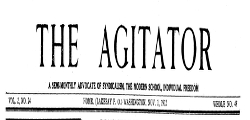
Agitator, The. Later renamed The Syndicalist (1910 – 1913) The expression of pre-WWI revolutionary syndicalism in the U.S. Organized by Earl Ford, J.W. Johnstone, William Z. Foster, they formed various syndicalist organizations inspired by the revolutionary syndicalism of the French CGT. Failing to win over the IWW to this brand of unionism, his followers set up the Syndicalist Militant Minority League in Chicago. Soon afterwards renaming the paper The Syndicalist as the organ of the Syndicalist League of North America. Unlike the IWW which attempted to compete with the AFL head on, the SLNA attempted to “Bore from within” the AFL. Thanks to the work of Marty Goodman of the Riazanov Library Project for the work in digitizing The Agitator & The SyndicalistSee Archive. | |

American Appeal (1926 – 1927) American Appeal newsaper was the closest thing to an official organ of the Socialist Party of America in the 1920s. Officially edited by Eugene V. Debs for the few years leading up to his death, this paper was published weekly out of Chicago. The scans are from original bound volumes but of limited quality due to their age. We present here below the the 7th and 8th volumes, 1926 and 1927 respectively.Thanks to the work of Marty Goodman of the Riazanov Library Project for the work in digitizing The Agitator & The SyndicalistSee Archive. | |

American Socialist (1914 – 1917) American Socialist newspaper was the offical organ of the Socialist Party of America in the pre-WWI years. Published in Chicago it was edited by J. L. Enghdal. It relfected the reformist and electoralist tendencies of the leadership of Party nationally at that time while at the same time providing a platform for the most coherent radical voices opposing the Imperialist war, which the U.S. had not yet entered. It was also very much a campaign paper covering the increasing number of electoral victories of the SP at this time. Of special note was the coverage it afforded the left-wing anti-war candidacy of Eugene V. Debs.See Archive. | |
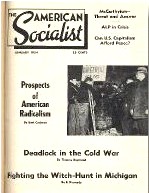
American Socialist (1956-1959) Monthly Periodical of the American Socialist Union, a small split from the US Socialist Workers Party. The organization, The Socialist Union, was a conscious attempt to pursue a different model from traditional Marxist-Leninist organizations in the US and abroad. In combination with their monthly magazine, The American Socialist, they attempted to start a new Marxist current that would dispense with the sectarian habits of the past. Although the magazine was published for only six years, from 1954 through 1959. Among it’s writers were Bert Cochran, Genora Dollinger (founder of the UAW’s Ladies Auxiliary during the 1936-37 Flint Sitdown Strike), Harvey O’Connor, Harry Braverman, W.E.B. DuBois, Conrad Lynn, Isaac Deutscher.See Archive. | |
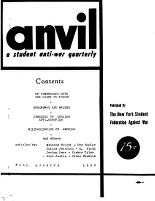
Anvil (1952-1960) Anvil was launched by the New York Student Federation Against War, an amalgamation of several socialist and radical campus clubs in New York City. For the first two issues, the publisher was listed as the Federation alone; thereafter and up through the 12th issue, to the name of the Federation was added a number of radical and socialist clubs in other parts of the country, the list varying from time to time. The New York Student Federation had never really developed as a going concern apart from the constituent clubs, and it ceased to be listed beginning with the 13th issue. In fact, no student groups as such were thenceforth listed as publishers, the sponsorship being represented only by the editorial board. At its founding the editor was Julius Jacobson. He was eventually succeeded by Bob Bone (10th issue), Margaret Levi (11th-13th), Don Harris (14th), George Rawick (15th-18th), and Michael Harrington (19th-20th).See Archive. | |
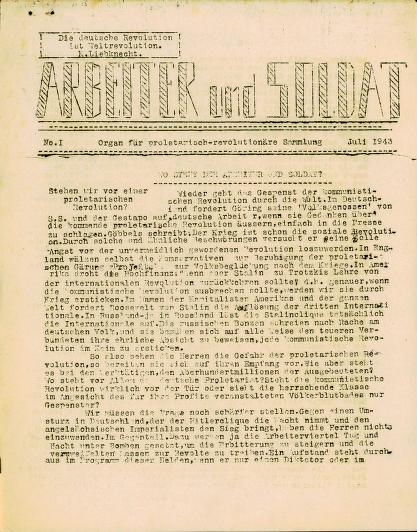
Arbeiter Und Soldat/Worker and Soldier (1943-1944) Produced in occupied France during WWII this journal was produced by French Trotskyists in conjuction with German Trotskyists drafted into the German Army and serving in the occupation forces. A descritpion in Yvan Craipeau’s book Contre vents et marées (Against winds and tides) quotes Roland Filiâtre, one of the comrades responsible for this work: “The French comrades started discussions with German soldiers and got them talking and giving hints of their past politics. Once they had shown themselves trustworthy, after screening they were put in touch with the German soldiers who produced Der Arbeiter and then taken care of by their organisation. The Paris region was organised as two branches. But the heart of the organisation was in Brittany, both around Nantes and in particular around Brest where the soldiers provided the party with Ausweis [identity cards] and weapons. In Brest the organisation had about fifty soldiers on average despite some people being posted elsewhere. Contacts were established in Toulon, Valence, La Rochelle and at Conches aerodrome. Links were established with the German Trotskyist organisation, most importantly in the port of Hamburg, in Lübeck and in Rostock. Victor [a German Trotskyist, whose real name was Widelin] was responsible for these contacts. Arbeiter und Soldat was also distributed in garrisons in Italy. On 7 October 18 Fourth International Committees activists in Brittany were arrested, along with much of the Paris organisation. In total around fifty French activists were rounded up, and many of them were tortured, executed or sent to concentration camps. Similarly, as many as fifty Der Arbeiter soldier comrades were put to death, and their paper never reappeared.”See Archive. | |

Bulletin (1966-1998) Published out of New York. This paper started out as the organ of the “American Committee for the Fourth International” that resulted from a split 1965 in the U.S. Socialist Workers Party. Aligned internationally with the Socialist Labour League (later renamed the Workers Revolutionary Party) the paper was initially titled Bulletin of International Socialism. Shortly into the 3rd volume the name simply became The Bulletin and the group publishing it became the Workers League. Unique on the left in the U.S. the paper by the 1970s became a twice-weekly journal and toward the end of that decade, became the first paper to use full color half-tones for color photographs on it front and back pages and then later its center pages. In the 1998 the paper became the The International Workers Bulletin and the ceased operations as a printed magazine taking on a web presence instead.See Archive. | |

Call (London 1916-1920) The journal of the BSP after the split on the issue of the war, the weekly The Call, lasted from 24 Feb.1916 – 29 July 1920 when it transmuted into The Communist. (It has been microfilmed and is thus available elsewhere but some of the paper copies in the British Newspaper Library which I consulted are in very poor condition. It is also available in Hull University and the National Library of Scotland while there are microfilm copies at the LSE.) It was started in anticipation of a split in the BSP which eventuated two months later at Easter 1916 – 24-25 April. Despite the success of the split from Hyndman, since the slaughter of the war went on and the mood of Britain was still very patriotic, the mood of the paper is gloomy, indeed the battle of the Somme started in July 1916 while the Irish rebellion was crushed during its opening conference. One has the impression that an immense change in optimism occurred after the first Russian Revolution which was warmly greeted in the paper on the 22 March 1917. There was a huge growth in all the Marxist currents in Britain without much direct Russian involvement through instructions or money. Still the BSP, as in the pre-Hyndman era, up to the end of 1918 though its members were often exceedingly active in the Trade Unions did not try to organise their members in groups and develop a line therein in the Bolshevik style.See Archive. | |
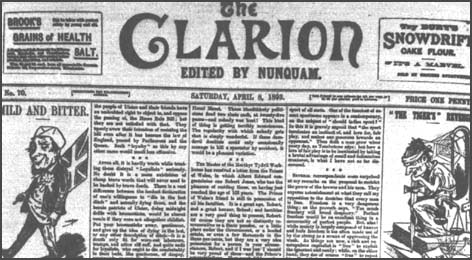
Clarion (London 1891-1894) Weekly newspaper published by Robert Blatchford, based in the United Kingdom. For most of its history, it was a socialist publication. Blatchford and Alexander M. Thompson founded the paper in Manchester in 1891. In it, he serialised his book, Merrie England, and published work by a variety of journalists, including George Bernard Shaw and the cartoonist Walter Crane. A large number of clubs and societies connecting with the newspaper were created, of which the National Clarion Cycling Club still survives. As does the People’s Theatre, Newcastle upon Tyne, which began its life in 1911 as the Newcastle Clarion Drama Club.Enjoying sales of around 30,000 for many years, some readers left after it adopted stance in favour of the Boer War and against women’s suffrage. They rose again as it became associated with the Labour Party, and by 1907 had reached 74,000. The paper again lost readers when it supported World War I, and in 1924 switched its support to the Conservative Party. It folded in 1931. Commonweal was a British socialist newspaper founded in 1885 by the newborn Socialist League. Its aims were to spread socialistic views and to win over new recruits. William Morris, founder of the League, was its chief writer, money finder and "responsible head". John Turner, Ernest Belfort Bax and Eleanor Marx also regularly contributed articles. Its publishing office was at Great Queen Street, London. It ceased publication in 1894. See Archive. | |
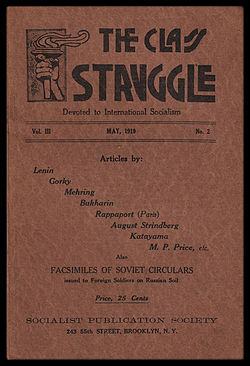
Class Struggle, The (New York City 1917-1919) The Class Struggle was a bi-monthly Marxist theoretical magazine published in New York City by the Socialist Publication Society. The SPS also published a series of pamphlets, mostly reprints from the magazine during the short period of its existence. Among the initial editors of the publication were Ludwig Lore, Marxist theoreticians Louis B. Boudin and Louis C. Fraina, the former of whom left the publication in 1918. In the third and final year of the periodical, The Class Struggle emerged as one of the primary English-language voices of the left wing factions within the American Socialist Party and its final issue was published by the nascent Communist Labor Party of America.Early in 1917, leading Russian-Jewish revolutionary socialist Leon Trotsky arrived in New York. He was immediately drawn into a meeting on January 14, 1917 of about 20 Left Wing Socialists at the home of German-American radical Ludwig Lore. Also attending the gathering were several other top emigrés from the Russian empire, including feminist Alexandra Kollontay, theoretician Nikolai Bukharin, and orator V. Volodarsky. Joining them were Sen Katayama, an exile from Japan, engineer S.J. Rutgers, and leading American radicals Louis C. Boudin, Louis C. Fraina, and John D. Williams of the Socialist Propaganda Society of Boston. This meeting, called to discuss "a program of action for Socialists of the Left," debated whether American radicals should separate themselves from the Socialist Party of America or stay within the organization. While Bukharin called for a prompt split, Trotsky sought the Left Wing to remain in the party and won the debate on the question. The January 14 meeting formed a subcommittee to construct a definite proposal for the next session of the group. This committee came back with a proposal for the establishment of a bimonthly theoretical journal to further advance the views of the Zimmerwald Left in America. The Class Struggle would ultimately emerge as the publication envisioned by this committee established by New York City radicals. The Class Struggle was produced by a publishing holding company known as the Socialist Publication Society. Physical production of the magazine took place at the 15 Spruce Street address of the New Yorker Volkszeitung, the German-language socialist daily newspaper then edited by Ludwig Lore. See Archive. | |
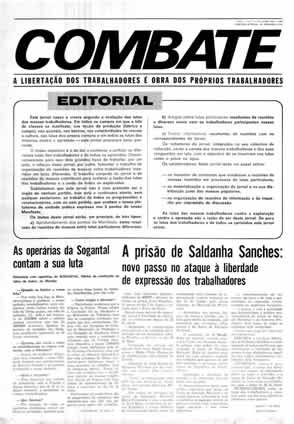
Combate (Portugal 1974-1978) Este jornal nasce e viverá segundo a evolução das lutas das massas trabalhadoras. Em todos os campos em que a luta de classes se manifeste, nos locais de produção (fábrica e campo) nos quartéis, nos bairros, nas colectividades de recreio e cultura, nas lutas dos presos comuns e em todas as lutas das minorias contra a opressão — este jornal procurará estar presente.O nosso objectivo é o de dar a conhecer e unificar as diferentes lutas dos trabalhadores e de todos os oprimidos. Desenvolveremos para isso dois grandes tipos de trabalho: por um lado, o reforço deste jornal, por outro, fomentar o trabalho de organização de reuniões de massas entre trabalhadores inseridos em lutas diferentes. O trabalho conjunto do jornal e de reuniões de massas contribuirá para acelerar a fusão das lutas doa trabalhadores e a união de todos os explorados. Sublinhamos que este jornal não é nem pretende ser o órgão de nenhum partido, mas está e continuará aberto, sem qualquer sectarismo, ao trabalho de todos os progressistas e revolucionários, com ou sem partido, que aceitem a nossa plataforma de unidade prática expressa nos 9 pontos do nosso Manifesto. See Archive. | |
|
Commonweal After splitting from Hyndman’s Social Democratic Federation, in 1884, the Socialist League, led by William Morris, published Commonweal, a monthly. It had around it some talented writers including Belfort Bax and the Avelings. After 1888 it was taken over by the anarchists and rapidly declined without the talents of Morris and Bax. At its inception it was much livelier than the early Justice and its articles by Morris, Bax, and Eleanor Marx are worth reading today.See Archive. | |

Communist, The (Series 1919-1921) The Communist was an American radical newspaper the official voice of the nascent American communist movement. The publication, replaced by the official organ of the new Communist Party of America, a weekly newspaper known as The Communist. Other periodicals named "The Communist" were published from 1929 to 1932, and in 1968. The issues below are a list of the full run of the serial’s first incarnation. Writers for the Periodical included Louis Frainia, V. I. Lenin, John Reed, Leon Trotsky, and many others.See Archive. | |
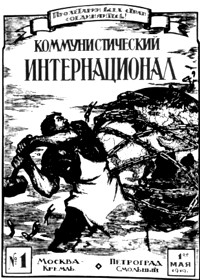
Communist International (‘Old’ & ‘New’ Series 1919-1926) Organ of the Executive Committee of the Communist International. It was founded in May of 1919 as part of the activities of the Communist International. Put out in half a dozen languages all Communist Parties, sections of the Comintern, learned of the positions of the Comintern through this monthly magazine.While the varoius Congress decissions were translated and reprinted inside of Communist International, it was also used to help build the various secitons of the Comintern during the early years of the International while Lenin lived. Writers for the Periodical included V. I. Lenin, Leon Trotsky, Gregory Zinoviev, A. Kaminov, August Thalheimer, R. N. Roy and many others. See Archive. | |

Communist (CPGB Weekly 1920-1923) This was the weekly organ of the Communist Party of Great Britain launched July 29, 1920. During the Bolshevization period it was renamed The Workers’ Weekly.See Archive. | |
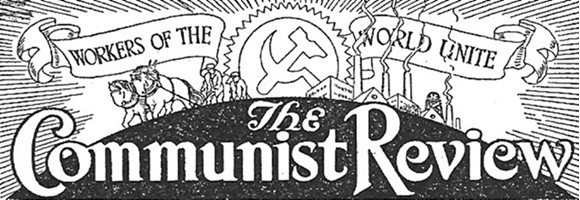
Communist Review (CPGB Monthly 1921-1924) First theorectical journal of the Communist Party of Great Britain 1921 through 1924. “THE COMMUNIST REVIEW makes its appearance in response to the new needs arising in the revolutionary movement of Great Britain. One of the main features of our magazine will be a complete record of what is happening in the Labour and Communist organisations of other countries. We shall also attempt to give a monthly survey of the foreign Communist Press, and in this way help to emphasise the international character of our movement. THE COMMUNIST REVIEW will thus open a new epoch in the history of revolutionary journalism in this country.”“We shall not attempt to make THE COMMUNIST REVIEW a magazine containing popular articles for non-Communist readers; its pages will rather appeal to the new Communists who are daily pouring into our ranks, and to those who may feel the need for a journal specially devoted to the discussion of revolutionary problems and tactics, as these present themselves, both at home and abroad. In each issue we intend to give a brief summary of the leading events that happen in Britain. We shall publish a monthly article in which the Communist Party of Great Britain will examine some important phase of the revolutionary movement as it affects the working class in this country. Members of the Party will find that we intend to publish reports from the branches and to summarise the general work of our organisation in its various avenues of activity. We hope, also, to find space to draw attention to any important volumes which may be published, and which, in our opinion, might interest our readers and assist them in their educational and agitational work. In a word, THE COMMUNIST REVIEW a will, we are sure, become an indispensable magazine to every member of out Party. ” See Archive. | |

Daily Worker, The (CPUSA daily, Chicago, New York City, 1924-1956) The Daily Worker was a newspaper published in New York City by the Communist Party USA, a formerly Comintern-affiliated organization. Publication began in 1924. While it generally reflected the prevailing views of the party, some attempts were made to make it appear that the paper reflected a broader spectrum of left-wing opinion. At its peak, the newspaper achieved a circulation of 35,000. Notable contributors to its pages included Robert Minor and Fred Ellis (cartoonists), Lester Rodney (sports editor), David Karr, Richard Wright, John L. Spivak, Peter Fryer, Woody Guthrie and Louis Budenz. The Daily Workers ancestry goes back to the weekly Ohio Socialist published by the Socialist Party of Ohio out of Cleveland from 1917 to November 1919. The Ohio party joined the nascent Communist Labor Party at the 1919 Emergency National Convention. The Ohio Socialist became Toiler in November 1919. In 1920, with the CLP going underground, Toiler became the party’s “aboveground” newspaper published by “The Toiler Publishing Association.” It remained as the Cleveland aboveground publication of the CLP and its successors until February 1922. In December 1921 the “ aboveground ” Workers Party of America was founded and the Toiler merged with Workers Council of the Workers’ Council of the United States to found the six page weekly The Worker. This became The Daily Worker beginning January 13, 1924.See Archive | |

Fight – Against War and Fascism (1933-1939) Fight Against War and Fascism newspaper was the American League Against War and Fascism, an organization formed in 1933 by the Communist Party USA and pacifists united by their concern as Nazism and Fascism rose in Europe. In 1937 the name of the group was changed to the American League for Peace and Democracy. The newspaper folded along with the organization when the Hitler-Stalin Pact was signed in 1939See Archive | |
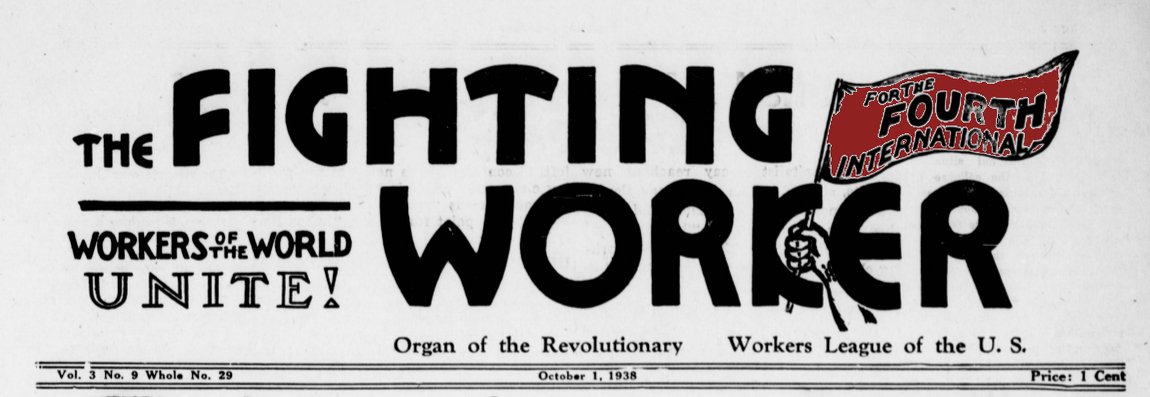
Fighting Worker (1936-1953) New York/Chicago: Newspaper of the Revolutionary Workers League (1936 through 1953), a split from the U.S. Workers Party of the U.S., was lead by Hugo Oehler. The RWL was an early split from the Workers Party of the U.S., the U.S. supporters of Leon Trotsky and the International Left Opposition. The RWL ceased calling themselves Trotskyist from 1938 onward. Their original opposition to the politics of the Workers Party revolved around the 1936 entry of the Trotskyists into the Socialist Party.See Archive | |

Fight (1936-1938) London. The monthly magazine of the British Marxist Group and Revolutionary Socialist League from 1936 through 1938. The collection here is made from a facsimile reproduction published in the 1990s.See Archive | |
|
Forward! (later Forward) (1975-1982) Kingston, Jamaica. The organ of the Jamaican Revolutionary Marxist League (RML), the only Trotskyist organization ever to exist in the West Indian island nation. The paper initially carried the descriptor “Propaganda Organ of the Revolutionary Marxist League” and while that was replaced with “Break the Chains, and let Workers and Small Farmers Rule!” Forward carried on propagandizing for the need for socialist revolution while focusing on the Jamaican labor scene, the post independence political struggles in Jamaica and other West Indian nations as well as making concerted efforts to address the international class struggle though a regular column entitled World Revolution. Because of the RML’s fraternal relations and later fusion into an international tendency with the U.S. based Revolutionary Socialist League(RSL), it sometimes reprinted articles from the RSL’s organ the Torch. Forward also carried two regular columns, Picket Lines and Woman’s Fight. The first issue of the paper was published in November 1975 and the last issue available in this index is from March–April 1982. There is a complete index for the years 1979–1981, however, since the creator of the index does not have access to a full catalog of the journal some issues are missing for the year 1978, there are no issues available for the year 1976, the year 1977 is incomplete and since so little is known of the RML, there is no clear indicator when the last issue of the journal was published.See Archive | |

Fourth International (New York 1940-1956) This journal represented the continuation of Trotskyist politics in the United States after the tendency in the Socialist Worker Party that formed around Max Schactman split and took the SWP theoretical journal with them, New International [see entry on NI below]. The index is in two parts: 1940-1945 and 1946-1956. In 1956 the magazine was renamed International Socialist Review. The index for ISR goes up to March 1970 at the moment.See Archive. | |
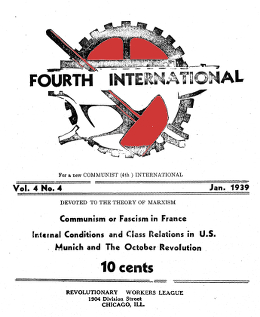
Fourth International (1936-1939) Chicago. Theoretical journal of the Revolutionary Workers League in the U.S., edited by Hugo Oehler and Thomas Stamm. This was the contintuation of the shortlived International NewsSee Archive. | |

Good Morning (1919-1921) Good Morning was an American left-wing humor magazine published from 1919 to 1922 by the cartoonist Art Young. Other contributors included Ellis Jones, Samuel Roth and Mabel Dwight. The first issue appeared on 8 May 1919, with Young collaborating with Ellis Jones. The magazine’s slogan was ‘A Weekly Burst of Humor, Satire and Fun With Now and Then A Fleeting Beam of Wisdom’. Though established as a weekly, Good Morning found survival hard. After a hiatus from July to October 1919 Young (now without Jones) re-established the magazine as a semi-monthly. With its slogan now ‘To Laugh That We May Not Weep’, the magazine kept its “independent, whimsical leftist slant”.See Archive. | |

Health & Hygiene (1935-1938) Health & Hygiene Publication launched with support from the Communist Party, USA in 1935 to give a leftist perspective on issues surrounding health care in America. It was sub-headed as “The Magazine of the Daily Worker Medical Advisory Board”.See Archive. | |

Industrial Organizer (1941-1942) The Industrial Organizer, the continuation of the Northwest Organizer which ended in July of 1941, was the voice of the most militant section of the U.S. working class in the late 1941. [The Industrial Organizer published through May of 1942 when it ceased publication. We have only 9 issues available but we will add the full run of the paper by the end of 2012.] The Trotskyist lead Local 544-CIO was under attack by both Daniel Tobin, the boss of the International Brotherhood of Teamsters and the FDR government who saw Local 544-CIO as a threat to labor peace they were trying to impose on the northern Central States. Much of the paper is is devoted to defending the Local from these attacks are well as reports on other militant actions by the working class during this period. Digitization of Industrial Organizer by the Riazanov Library Project.See Archive. | |

Industrial Union Bulletin / Industrial Worker (1907 - 1913) The Industrial Union Bulletin, and the Industrial Worker were newspapers published by the Industrial Workers of the World (IWW). Representing the socialist and revolutionary syndicalist views of early industrial organizing, these papers chronicalled the fierce, sometimes armed, class struggles of the pre-WWI period during the height of America’s industrial oligarchical period. The IWW was the most radical trade union in U.S. History. The Industrial Worker, "the voice of revolutionary industrial unionism," is the newspaper of the Industrial Workers of the World (IWW). It is still published to this day and is the longest running radical newspaper in the U.S.See Archive. | |
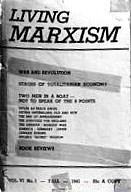
International Council Correspondence Living Marxism (1934-1943) The International Council Correspondence, council communist journal published in Chicago 1934-43. In 1938, the journal changed its name to Living Marxism and again to New Essays in 1942. Paul Mattick was its chief editor and contributor. Among others, Karl Korsch, Anton Pannekoek and Otto Rühle contributed to its pages. The journal’s original purpose was to correspond with fellow council communists, primarily in Europe. However as the European council communists began to go underground in the late 1930s, the journal changed its name.See Archive. | |

International Socialism (London 1958-1978) This journal was originally published in 1958 as a duplicated theoretical magazine by the Socialist Review Group then working in the Labour Party. After one issue in that format the following two numbers were produced in 1959 as a joint issue in the form of a book length study of Rosa Luxemburg by Tony Cliff. In 1960 the journal resumed publication, this time in printed form, with an editorial board drawn from a variety of tendencies but retaining its link with the SRG, which became the International Socialists in 1962. The International Socialists were renamed the Socialist Workers Party 1977 and the magazine ceased publication in this format at the beginning of 1978 (No.104) and was replaced by a book-format journal, which retained the name International Socialism but restarted the numbering, and a monthly magazine called Socialist Review.See Archive. | |

Labor Action (New York 1940-1958) Labor Action was published in the United States by the Workers Party a party founded as the result of a split with the Socialist Worker Party in the Spring of 1940 shortly after the SWP itself was founded. The major political issue was over the class nature of the U.S.S.R. with the majority of the SWP taking the position held by Leon Trotsky that this state was a workers state and not a state run by a "class of a new type" as advocated by those that formed the new Workers Party. The Workers Party’s most prominent member was Max Shachtman. Many writers that were previously associated with the SWP joined the new, but smaller, Workers Party, including James T. Farrel, Hal Draper, CLR James and James Burhnam (the latter of whom quickly abandoned all references to Marxism and moved to the far right of America’s political spectrum).The appearance of the broadsheet Labor Action added another source of news for the continuing labor struggles in the U.S. where the line of Labor Action within the labor movement appeared similar to that of Socialist Appeal and The Militant, the organs of the SWP. See Archive. | |
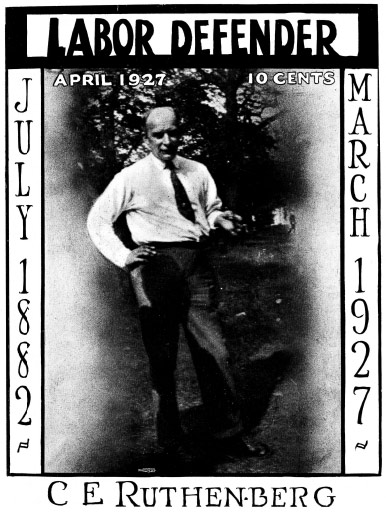
Labor Defender (1926-1927) International Labor Defense (ILD) was the consolidated legal defense mass organization headed by the Workers Party of America from 1925. It replaced the Labor Defense Council, the WPA’s previous mass organization formed for purposes of legal defense. The ILD began with a discussion between James P. Cannon and "Big Bill" Haywood in Haywood’s room in Moscow in 1925. A plan was arrived at for a non-partisan body that would defend any member of the working class movement, without regard to personal political views. Any working class activist who came under the thumb of persecution by the capitalist legal system would be supported legally, morally, and financially. After preliminary negotiations in Moscow, an agreement was reached outlining the procedure for organizing the ILD and outlining its relationship to two Comintern-related international aid organizations, International Red Aid (MOPR) and International Worlers’ Relief (WIR). This magazine was published monthly by the International Labor Defense (ILD), a Communist Patry led partisan defense organization but, with broad based support and oversight, designed to provide legal assistance for strikers and other workers imprisoned during labor struggles.See Archive. | |

Labour Monthly, The (London 1921-1981) Founded in 1921, The Labour Monthly was a theoretical journal edited by R. Palme Dutt that provided a forum for the wide circulation of articles by Communist Party of Great Britain members, socialists and militant trade unionists.See Archive. | |

Labour Review (London 1952-1963) This journal was published in London from 1952 until 1963 by the tendency associated with Gerry Healy. Originally it appeared very sporadically but from 1957 it appeared more regularly. From 1957 until 1959 it was one of the finest non-sectarian theoretical journals on the left internationally. With the foundation of the Socialist Labour League it became increasingly inward looking and was replaced by a journal called Fourth International in 1964.See Archive. | |

Militant\New Militant, The (New York 1928-1936) Published as the journal of the U.S. Trotskyist movement beginning with issue Volume 1, No. 1 Nov. 15, 1928. As the Trotskyist movement fused and split over the next 10 years, the paper, like the name of the movement itself, went trough several permunations (always published in New York): Communist League of America, 1928-34; New Militant, published by the Workers Party of the United States, Dec. 15, 1934 – June 6, 1936; Socialist Appeal (see below) from 1936 through 1941; The Militant, again, published by the Socialist Workers Party, 1941-present.See Archive. | |
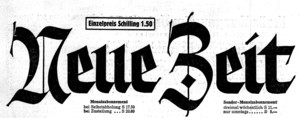
Neue Zeit (Stuttgart 1823-1923) A magazine – the theoretical organ of German Social-Democratic Workers’ Party, published in Stuttgart from 1883 to 1923.World War I the journal took a centrist stand. The journal was edited by K. Kautsky from its creation until October 1917, and then by H. Cunow. Some of the writings of the founders of Marxism were first published in this journal, among them K. Marx’s Critique of the Gotha Programme and Engels’s “Criticism of the Draft Social-Democratic Programme of 1891”. Other prominent leaders of the German and international labour movement who contributed to the journal at the end of the nineteenth and beginning of the twentieth centuries were A. Bebel, K. Kautsky, W. Liebknecht, R. Luxemburg, F. Mehring, Clara Zetkin, G. V. Plekhanov and P. Lafargue. Beginning with the late nineties, the journal raised controversy by publishing articles by revisionists, including a series of articles by E. Bernstein “Problems of Socialism”. During World War I the journal took a centrist stand. See Archive. | |

Ohio Socialist, The (Cleveland, Ohio, 1918 – 1920) Newspaper of the Ohio Socialist Party it represented the left wing of the Socialist Party of the America. Strong supporters of Eugene V. Debs it’s editors and readers became supporters of the newly founded Communist Labor Party in 1919. It merged The Communist to become The Toiler as the main weekly of the new communist movement. See Archive. | |

New Review, The (New York City 1913 – 1917) This journal’s purpose was make known “the intellectual achievements of Marx and his successors” to the “awakened, self-conscious proletariat on the toilsome road that leads to its emancipation.” In practice, it proved to be a theoretical magazine by intellectuals, for intellectuals. This was in 1913. Never intending to be ideologically homogeneous, the trend of “The New Review” over the three-and-a-half years of its existence was from Center to Left. The magazine was active in attempting to make sense of the hot button issues of syndicalism and mass action in 1913, maintaining a sympathetic posture. It provided a forum for the writing of two of the principals of left wing New York literary-artistic magazine “The Masses,” Max Eastman and Floyd Dell. It dealt extensively with the issues of feminism, American intervention in Mexico, the growth of militarism, and the role of the International Socialist movement in the war.Over time the wunderkind of American radicalism, Louis C. Fraina, came to play an increasing role in the magazine, helping move it on its generally leftward path. Other editorial contributors of note over the publication’s history included Herman Simpson, Louis B. Boudin, William English Walling, Moses Oppenheimer, William E. Bohn, Frank Bohn, and Isaac Hourwich. See Archive . | |
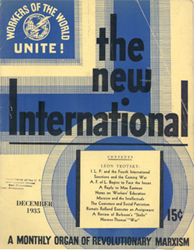
New International (New York 1934-1958) The magazine was founded as the organ of the Trotskyist group, named the Communist League of America, which formed out of a split from the Communist Party. The CLA merged with the American Workers Party (a left-socialist group led by A.J. Muste, James Burnham et al.), to form the Workers Party of the US (Jan. 1935 issue). The magazine was suspended (last issue: June 1936) when the Trotskyists joined the Socialist Party and was reissued (Jan. 1938) when they split with the Socialist Party, forming the Socialist Workers Party. The SWP in turn split in the spring of 1940, and the magazine went (Apr. 1940) with the then minority, which organized itself under the name of Workers Party. This organization changed its name to Independent Socialist League after April 1949. Throughout these political changes, the formal publisher of the magazine was the “New International Publishing Company” (except for the first year, 1934, when it was the “New International Publishing Association”). At present the index by issue is more or less complete. It is divided into three sections: 1934-1940 (until the split), 1940-1946 and 1947-1958 (when the magazine ceased publication).See Archive. | |
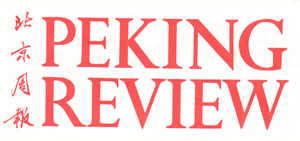
Peking Review (Beijing) En Esapañol: Pekin Informa Starting on March 4, 1958 and continuing to the present, the People’s Republic of China has published a weekly English-language news magazine originally called “Peking Review”, and beginning with issue #1 in 1979 renamed “Beijing Review” after the Pinyin transliteration system was adopted. The magazine, reflectd the views of the Communis Party of China and was meant to co-ordinate their line for their supporters around the world grouped in various Communist Parties that looked to Beijing and not Moscow for guidance.See Archive, En Español: Pekin Informa. | |
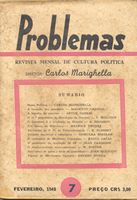
Problemas: Revista Mensal de Cultura Política (Rio de Janeiro) Editada pelo PCB - Partido Comunista do Brasil. Circulou de Agosto de 1947 até 19??. [Publication of the Communist Party of Brazil.]Iniciamos com o presente número de PROBLEMAS, a publicação mensal de uma revista de cultura política, tendo por base a divulgação e o debate de artigos e estudos marxistas. Nunca é demais repetir a clássica afirmação, tantas vezes já confirmada pelos fatos, de Lenin, de que sem teoria revolucionária não pode haver tampouco movimento revolucionário. Torna-se indispensável, de fato, em nossa terra, difundir o conhecimento e o debate das idéias marxistas-leninistas como uma contribuição básica para o desenvolvimento da luta de nosso povo, em defesa da democracia, da independência e do progresso de nossa Pátria. O marxismo-leninismo é a teoria de vanguarda do proletariado, a ciência social que conduz a humanidade à democracia e ao progresso, é um método de análise aplicado a todos os conhecimentos humanos, é a cultura em marcha, em seu duplo sentido geral de crítica e criação com a herança de todo o patrimônio cultural do passado, com a aquisição de novos valores e de novas experiências baseadas na atividade prática. See Archive. | |
 
Proletarian Revolution (previously Socialist Voice) Journals of the League for a Revolutionary Party, a New York based Trotskyist group. Founded as a split from the Revolutionary Socialist League, itself a split from the International Socialists. “The League for the Revolutionary Party (LRP) has been formed to carry out the struggle for revolutionary leadership of the working class that was undertaken in the past by the Revolutionary Socialist League (RSL). The RSL’s left wing, the Revolutionary Party Tendency, was expelled on February 15th of 0f 1974, and its members joined with previously-expelled comrades including Central Committee members Sy Landy and Walter Dahl to organize the LRP. The LRP stands for the program of Lenin and Trotsky, the revolutionary communism of our epoch, that is rapidly being abandoned by the RSL.”See Archive. | |
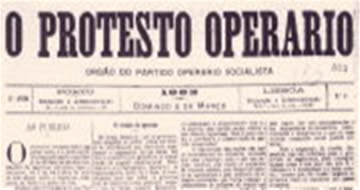 Protesto Operário (Lisbon) Órgão do Partido Operário Socialista Em Portugal, com a fundação do Partido Socialista a 10 de Janeiro de 1875 dois novos jornais de carácter socialista foram criados: «O Protesto» e «O Operário», os quais mais tarde se haveriam de fundir para dar lugar ao «Protesto Operário», órgão do Partido Socialista e que mantinha uma redacção em Lisboa e outra no Porto. Circulou de março de 1882 até 1???.See Archive. | |
 Revolutionary Age, The (Boston, Ma.) The Revolutionary Age was an American radical newspaper edited by Louis C. Fraina and published from November 1918 until August 1919. Originally the publication of Local Boston, Socialist Party, the paper evolved into the de facto national organ of the Left Wing Section of the Socialist Party which battled for control of the Socialist Party throughout the spring and summer of 1919. With the establishment of the Left Wing National Council in June 1919, the paper was moved from Boston to New York City thus gaining status as the official voice of the nascent American communist movement. The publication was terminated in August 1919, replaced by the official organ of the new Communist Party of America, a weekly newspaper known as The Communist.T Other periodicals named "The Revolutionary Age" were published from 1929 to 1932, and in 1968.See Archive. | |
 Revolutionary Age, The (New York City) The Revolutionary Age was an American radical newspaper edited by Jay Lovestone for the Communist Party, USA (Majority Group), known as the Right Opposition because internationally it was aligned with the Right Oppositionist N. Bukharin in the U.S.S.R. This tendency also included leading CPUSA founder, Ben Gitlow. In 1932 the paper changed it's name to Workers Age.See Archive. | |
 Socialist Appeal (1935-1937, Chicago, Ill.) This magazine was started by Albert Goldman, a supporter the Trotskyist movement in the United States who formally left the Workers Party of the United States, the US Section of the International Left Opposition, to enter into the Socialist Party of America and work and develop this party’s left-wing, which had been growing under the impact of the Depression. The paper was started in 1935 and was shortly joined by the official membership of the Trotskyist movement in the U.S. lead by James P. Cannon. The Trotskyists stopped publishing their organ, The New Militant and joined in publishing Socialist Appeal. Socialist Appeal remained the Trotskyist faction’s paper through the establishment of the Socialist Workers Party after their expulsion from the Socialist Party in January of 1938. There was a concurrently published in New York City, officially noted as the “Organ of the Socialist Party of New York, Left Wing Branches” with the same editorial positions as the Chicago Socialist Appeal. The first issue of this paper is from August 14, 1937, Volume 1, No. 1. This New York Socialist Appeal was published as a weekly and became the paper of the SWP mentioned above, merging any resources it had from the Chicago Socialist Appeal. Socialist Appeal was changed back to The Militant in 1941. The last issue is noted as Volume 5, No. 4, January 25, 1941.See Archive. | |

Socialist Appeal (1937-1941, New York City) Published in New York City, officially sub-titled as the “Organ of the Socialist Party of New York, Left Wing Branches” with the same editorial positions as the Chicago Socialist Appeal, noted above. The first issue of this paper is from August 14, 1937, Volume 1, No. 1. This New York Socialist Appeal was published as a braod sheet weekly. After the Left Wings Branches were expelled from the SP, they went on to establish the Socialist Workers Party in January of 1938 and Socialist Appeal became the official party organ. Socialist Appeal was changed back to The Militant in 1941. The last issue is noted as Volume 5, No. 4, January 25, 1941. The index for this paper is listed in The Militant index as it’s a continuation of the same political tendency that originally put out the The Militant in 1928.See Archive. | |
|
Student Partisan (New York 1934-1953) From “Indexes to Independent Socialist Periodicals”, published by the Independent Socialist Press, Box 6332, Albany sta, Berkeley, Calif 94706, copyright 1969, 1970. This contains cumulative indexes for The New International 1934-1958, Anvil 1949-1960 and Student Partisan 1947-50 together with annual indexes for Labor Action 1949-1953 all compiled in 1969. Details and their introductions to the indexes are included in ETOL.This magazine was launched by the Politics Club of the University of Chicago at a time when radical student activities were making a new beginning in the postwar period but no student movement had yet appeared on a national scale. In many ways the University of Chicago campus was to the late ‘40s and ‘50s was what C.C.N.Y. had been in the ‘30s and Berkeley was going to be in the ‘60s: the campus with the most activity of a “student movement” type. The focus of this activity was the Politics Club. Its relatively large membership was more heterogeneous than radical clubs had tended to be. It included socialists of various tendencies and even some liberals; but the largest single political current in the club was that of the youth group of the Independent Socialist League, called the Socialist Youth League. It was their views which gave the main political tone to Student Partisan. A similar student magazine was launched in New York City in the fall of 1949: see the introductory note to the Anvil index in this volume. The two magazines were merged the following year, and the independent existence of Student Partisan came to an end after nine issues. In effect, the merged magazine continued Anvil (and continued Anvil‘s issue numbering), though the title became formally Anvil and Student Partisan. See Archive. | |
|
ToDay Today, a monthly, edited by E. Belfort Bax and J.L. Joynes, ran from Jan 1884 to June 1889 inclusive. See the editorial “To our Readers” for Jan 1884 describing its aims and objectives which were to be an open journal but stated it “will be the exponent of scientific Socialism, and the unsparing assailant of all our modern forms of competitive anarchy.” It cost 6d until April 1884, and thereafter 1/-. The Editorship was taken over by Hubert Bland in January 1889 before the journal changed its name to The International Review in July of the same year, the new editor being H.M. Hyndman. At least three monthly issues, July to September, of International Review were published by Hyndman in 1889.See Archive. | |
|
Western Worker (San Francisco 1932-1937) The Western Worker was the official newspaper of the Communist Party, USA for the western states on the U.S.See Archive. | |
|
Workers’ International News (London 1938-1949) Workers’ International League, 1938-1944; Revolutionary Communist Party, 1944-1949. Monthly, later irregular. Theroretical organ of the WIL and then the RCP until the dissolution of the party in 1949.See Archive. | |

Workers World, The (Kansas City, 1919-1920) Was a weekly publication of the Socialist Party in Kansas City, Missoiuri. It was edited at varying times by both Earl Browder who later went on to become Sect’y of the Communist Party and James P. Cannon, also a leader of the Communist Party who went to found the Trotskyist movement in the U.S. While associated with the Socialist Party, the paper was firmly in that party’s left-wing. It was one of the many left wing SP periodicals inspired by and firmly supporting the Russian Revolution, and (like many other such left wing SP periodicals) ended as those involved in it left the SP to organize the new Communist Party of America and Communist Labor Party, and develop new periodicals for those organizations. Because of this, these issues of The Workers World are located here in the Communist Party archive on the MIA.See Archive. |
